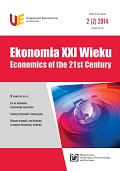Ochrona własności intelektualnej w obszarze komunikacji wizualnej
Protection of intellectual property rights in the field of graphic design
Author(s): Izabela Ścibiorska-Kowalczyk, Jarosław KowalczykSubject(s): Economy
Published by: Wydawnictwo Uniwersytetu Ekonomicznego we Wrocławiu
Keywords: intellectual property; graphic design; copyrights law; trademarks
Summary/Abstract: The purpose of this article is to present specific problems related to the violation of intellectual property in the field of visual communication and an attempt to identify more effective ways to protect it. Legal protection works in the area of visual communication do not guarantee respect for intellectual property. Jurisprudence encounters problems at the core of which is the discretionary nature of the assessment of the originality of artistic works. The article presents case studies that illustrate this state very clearly. Many artists do not enter a legal challenge in the case of plagiarism of their projects because of the uncertain effect of the procedure and troublesome and sometimes even expensive process. In case of violation of someone else’s intellectual property rights in respect of the works belonging to the area of visual communication the attitude of the designer is essential. Very important are also circumstances in which there is a breach of intellectual property. The analysis of these circumstances can be a starting point to searching for effective ways to prevent the infringement of intellectual property, with particular emphasis on the indication of the illusory benefits of this practice, obtained in such a specific field as visual communication. Possible courses of action in order to reduce the practice of intellectual property violations were proposed. The analysis of these measures is based on the concept of searching for the maximum benefit that can be achieved in co-operation of the designer with the customer. The analyses of individual situations lead to a conclusion that the designer has a maximum benefit when he fully realizes the original design, created as a result of a reasonably long and conducted with due diligence and thoroughness of the design process. Accordingly, strong emotional involvement in the project also creates a unique opportunity for artistic effect. Such a project, entitles the creator to a sufficiently high salary and provides him with an opportunity to promote and achieve further attractive orders. The customer has a maximum benefit in a situation when he receives a unique design, valuable in terms of art, that gives rise to the effective marketing activities. In the high-potential project the opportunities of reimbursement for the costs should be sought. The sphere of visual communication enters a period of formation of the patterns of behavior, including ethical ones. In an era of increasing competition not only the talent and artistic competence of the designer begins to count, but also the model of design process preferred by him and an opinion about him in the environment. It is also the place to assess the ethical behavior of designers and include it into the evaluation process of their selection by the customer. The attitude of the designer is of vital importance to the avoidance of a violation of intellectual property of somebody else. Equally important is the correct relationship between
Journal: Ekonomia XXI Wieku
- Issue Year: 2014
- Issue No: 02
- Page Range: 93-105
- Page Count: 1
- Language: Polish

